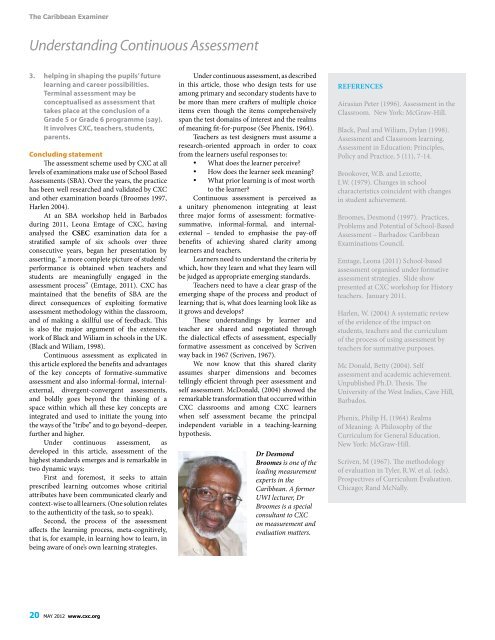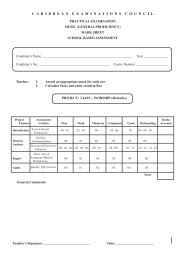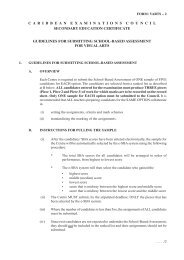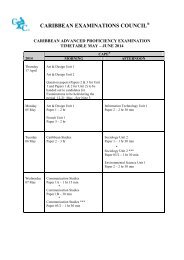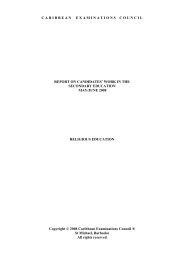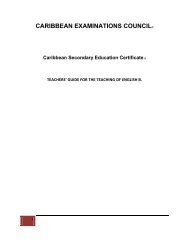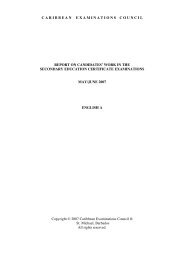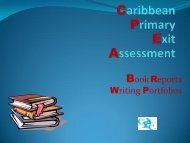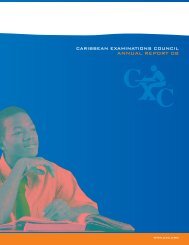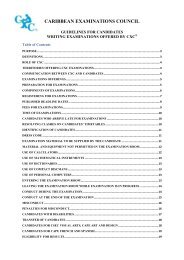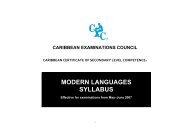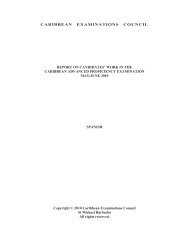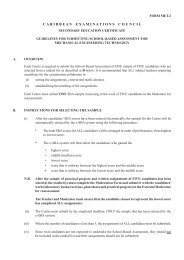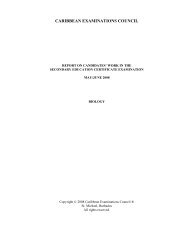CXC Examiner May 2012 - Caribbean Examinations Council
CXC Examiner May 2012 - Caribbean Examinations Council
CXC Examiner May 2012 - Caribbean Examinations Council
You also want an ePaper? Increase the reach of your titles
YUMPU automatically turns print PDFs into web optimized ePapers that Google loves.
The <strong>Caribbean</strong> <strong>Examiner</strong>Understanding Continuous Assessment3. helping in shaping the pupils’ futurelearning and career possibilities.Terminal assessment may beconceptualised as assessment thattakes place at the conclusion of aGrade 5 or Grade 6 programme (say).It involves <strong>CXC</strong>, teachers, students,parents.Concluding statementThe assessment scheme used by <strong>CXC</strong> at alllevels of examinations make use of School BasedAssessments (SBA). Over the years, the practicehas been well researched and validated by <strong>CXC</strong>and other examination boards (Broomes 1997,Harlen 2004).At an SBA workshop held in Barbadosduring 2011, Leona Emtage of <strong>CXC</strong>, havinganalysed the CSEC examination data for astratified sample of six schools over threeconsecutive years, began her presentation byasserting, “ a more complete picture of students’performance is obtained when teachers andstudents are meaningfully engaged in theassessment process” (Emtage, 2011). <strong>CXC</strong> hasmaintained that the benefits of SBA are thedirect consequences of exploiting formativeassessment methodology within the classroom,and of making a skillful use of feedback. Thisis also the major argument of the extensivework of Black and Wiliam in schools in the UK.(Black and Wiliam, 1998).Continuous assessment as explicated inthis article explored the benefits and advantagesof the key concepts of formative-summativeassessment and also informal-formal, internalexternal,divergent-convergent assessments,and boldly goes beyond the thinking of aspace within which all these key concepts areintegrated and used to initiate the young intothe ways of the “tribe” and to go beyond–deeper,further and higher.Under continuous assessment, asdeveloped in this article, assessment of thehighest standards emerges and is remarkable intwo dynamic ways:First and foremost, it seeks to attainprescribed learning outcomes whose critirialattributes have been communicated clearly andcontext-wise to all learners. (One solution relatesto the authenticity of the task, so to speak).Second, the process of the assessmentaffects the learning process, meta-cognitively,that is, for example, in learning how to learn, inbeing aware of one’s own learning strategies.Under continuous assessment, as describedin this article, those who design tests for useamong primary and secondary students have tobe more than mere crafters of multiple choiceitems even though the items comprehensivelyspan the test domains of interest and the realmsof meaning fit-for-purpose (See Phenix, 1964).Teachers as test designers must assume aresearch-oriented approach in order to coaxfrom the learners useful responses to:• What does the learner perceive?• How does the learner seek meaning?• What prior learning is of most worthto the learner?Continuous assessment is perceived asa unitary phenomenon integrating at leastthree major forms of assessment: formativesummative,informal-formal, and internalexternal– tended to emphasise the pay-offbenefits of achieving shared clarity amonglearners and teachers.Learners need to understand the criteria bywhich, how they learn and what they learn willbe judged as appropriate emerging standards.Teachers need to have a clear grasp of theemerging shape of the process and product oflearning; that is, what does learning look like asit grows and develops?These understandings by learner andteacher are shared and negotiated throughthe dialectical effects of assessment, especiallyformative assessment as conceived by Scrivenway back in 1967 (Scriven, 1967).We now know that this shared clarityassumes sharper dimensions and becomestellingly efficient through peer assessment andself assessment. McDonald, (2004) showed theremarkable transformation that occurred within<strong>CXC</strong> classrooms and among <strong>CXC</strong> learnerswhen self assessment became the principalindependent variable in a teaching-learninghypothesis.Dr DesmondBroomes is one of theleading measurementexperts in the<strong>Caribbean</strong>. A formerUWI lecturer, DrBroomes is a specialconsultant to <strong>CXC</strong>on measurement andevaluation matters.ReferencesAirasian Peter (1996). Assessment in theClassroom. New York: McGraw-Hill.Black, Paul and Wiliam, Dylan (1998).Assessment and Classroom learning.Assessment in Education: Principles,Policy and Practice, 5 (11), 7-14.Brookover, W.B. and Lezotte,I.W. (1979). Changes in schoolcharacteristics coincident with changesin student achievement.Broomes, Desmond (1997). Practices,Problems and Potential of School-BasedAssessment – Barbados: <strong>Caribbean</strong><strong>Examinations</strong> <strong>Council</strong>.Emtage, Leona (2011) School-basedassessment organised under formativeassessment strategies. Slide showpresented at <strong>CXC</strong> workshop for Historyteachers. January 2011.Harlen, W. (2004) A systematic reviewof the evidence of the impact onstudents, teachers and the curriculumof the process of using assessment byteachers for summative purposes.Mc Donald, Betty (2004). Selfassessment and academic achievement.Unpublished Ph.D. Thesis. TheUniversity of the West Indies, Cave Hill,Barbados.Phenix, Philip H. (1964) Realmsof Meaning: A Philosophy of theCurriculum for General Education.New York: McGraw-Hill.Scriven, M (1967). The methodologyof evaluation in Tyler, R.W. et al. (eds).Prospectives of Curriculum Evaluation.Chicago; Rand McNally.20 MAY <strong>2012</strong> www.cxc.org


